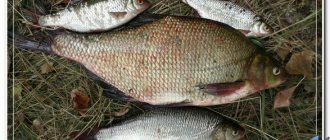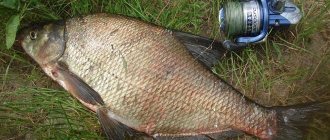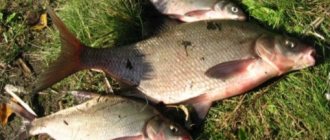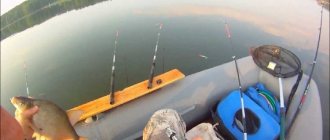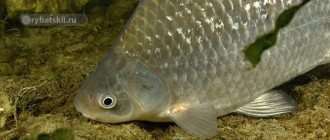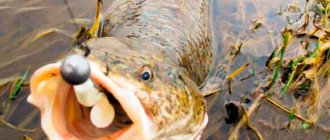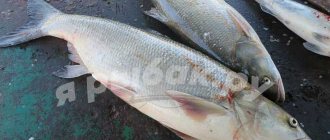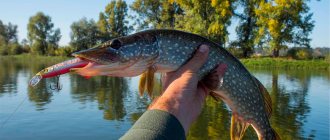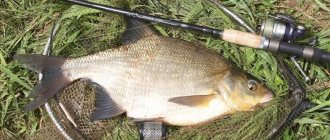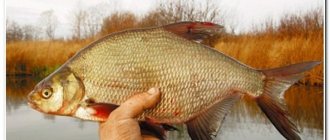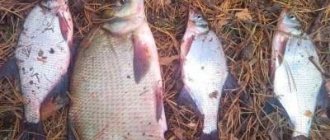Groundbait and preferred baits: general rules
In the autumn months, residents of reservoirs begin to prepare for winter. At this time, bream need as much protein as possible to survive the long winter under the ice. If in September the fish prefers to remain on a summer diet, then as cold weather sets in, it is necessary to increase the amount of protein in the menu.
It is worth including some peas in the bait at the beginning of autumn. It is boiled and passed through a blender. Be sure to mix peas with breadcrumbs, adding pieces of maggots and worms. You can replace the peas with canned corn. Boiled pearl barley or millet groats are also added to the bait. But a diet without animal protein will be useless.
Important! For 5 kilograms of bait you will need 100 grams of maggots or bloodworms. From the baits you need to choose those that are of animal origin. Worms, bloodworms, and maggots are best suited.
The ratio of the protein component increases as the water and air temperatures decrease. The main thing in feeder fishing is not to overfeed the bream. Therefore, it is necessary to wisely fill the feeders with nutrient mixtures. The pleasant aroma will attract fish, and the catch will be significant.
But there are a number of rules for attracting:
- Add maggots to feeders more often as fish activity decreases.
- From the end of October, the worm should be replaced with bloodworms.
- Food should be flavored sparingly.
- For aromatization, alcohol liquids with aromas of anise, pepper, lemon balm, anise, and coriander should be used.
- At water temperatures below 10-12 degrees, baits and bait made from plant components will not interest bream.
An attentive fisherman will experiment with baits, monitoring the behavior of the fish and its activity. Even animal food should be changed, starting with maggots, dung worms and switching completely to bloodworms until freeze-up. Mixtures for feeder fishing are purchased in specialized stores. But many people prefer to make their own bait.
Homemade bait recipe No. 1
The proportions of the prepared mixture should be observed so that the bream’s nutrition is high-calorie and balanced. Then the bite will be active. You need to calculate the components using small measuring cups. The mixture is based on special fish food. It will be sufficient in the amount of 2-dimensional units. Mixed with it:
- the same amount of roasted hemp seeds and breadcrumbs (3 m.u.);
- 1 part each of dry clay, egg powder;
- 3 parts crushed maggot;
- 2 pinches of dried dill.
Dry ingredients are steamed. The crushed mass of worms or maggots should be placed at the last moment after filling the feeder. Rusks are needed in bait to hold the nutritional mass together. The clay makes the feeder heavy, helping it sink to the bottom. During the current, fertilizer with clay is less washed away. In calm water, replace the clay in the nutrient mixture with sand. At the beginning of autumn, you can add some potato chips, after crushing them. They add flavor to the bait and contain a lot of calories.
DIY recipe No. 2
The nutritional mixture can be made by adding to it:
- hemp or flax bran;
- corn sticks, finely chopped;
- sunflower cake;
- bloodworm;
- maggot;
- dry clay.
Most of the complementary feeding is taken up by bloodworms (5 parts), maggots are taken a little less (3 parts). The plant component - cake occupies 3 parts, and bran - 2. The remaining ingredients - 1 part each. It’s worth adding a little dried mayfly and Zdorovye coffee powder. The main thing is that all the ingredients are crushed and moistened. Bloodworms and maggots are added in portions.
What flavors and dips work best?
You can attract bream to the feeder with aromas. In autumn they should not be sickly sweet as in summer. The smell of a worm and bloodworm works. The aroma of anise, cloves, cinnamon, and thyme will be attractive to the inhabitants of rivers and lakes. Don't add too much odorous liquid. Too much scent will only scare you away.
Feeding
Even baits for catching bream on a feeder in the fall are different from summer ones. Fishermen go different ways: they use exclusively purchased factory products or prepare their own. Some amateurs and professionals practice mixing.
The main rule of feeder bait is that it should mold well and stay firmly inside the feed container, despite the fact that washability is lower in cool water.
On the shelves of fishing stores there are mixtures with a mark on the pack: “Especially for cold water.” When fishing in the second stage (October–November), we need such baits. The food also differs depending on the fishing conditions. For standing waters, the use of mixtures with increased washability is required. They are not suitable for rivers on their own, as the water will quickly wash away.
IMPORTANT! If you don’t have a mix for the current on hand, but you have food for a quiet pond, that’s okay. Add a little clay to the bait, it reduces blurring. When the situation is opposite, adding sand is important.
There is an important nuance about the manufacturer. Before being released for sale, baits are tested in large bodies of water at different times of the year until the proportion of target fish caught exceeds 80–90%. Prototypes are tested, as a rule, in the same natural areas where they were manufactured. Within the same latitude (longitude), similar conditions prevail in all seasons, including autumn. Most of all, fishermen use TRAPER, MINENKO, and DUNAEV baits.
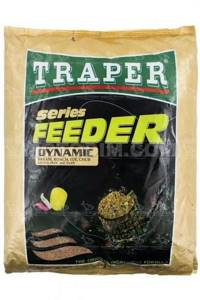
TRAPER for fast waters produces feeder baits marked “DYNAMIC”, that is, “movable”. This particular product can be called a universal remedy in terms of seasons. It indicates which fish should be caught with it. Among them is Leszcz.
With autumn cold weather, the situation is similar to the recommendations for bait. As the cold increases, the fisherman needs to add fresh bait to the feed: chopped red worms, maggots. With the onset of frost - bloodworms.
The addition of flavors also varies. During cold spells, when the water temperature drops, alcohol rather than oil additives are required. Experienced anglers have noticed that cocoa and molasses flavors work best.
What gear is used
A decrease in water and air temperatures pushes bream to migrate away from the shore. After all, in shallow water the water does not warm up and is covered with thin ice. The fish goes deeper. At this time of year, they change gear to a bottom fishing rod, or feeder.
The feature of the fishing rod will be:
- The rod is 3.9 meters long. On rivers with strong currents, you need gear with feeder feeders from 100 grams. On reservoirs and lakes, the feeder is represented by a long rod from 3.8 meters, a heavy river fish or a medium.
- The rod's construction is Progressive. The upper part of the blank will work under medium load, the entire length will work under strong impact.
- Special feeder reels. Heavy river fishing requires a spinning reel with a spool size of 5000. Light and medium class bottom fishing rods require reels of 4000.
- Monofilament fishing line with a diameter of 0.25-0.3 mm. It should not stretch, otherwise the bites will not be visible. It is better to use a special fishing line that says Fieder. This indicates the rigidity and inextensibility of the equipment.
- Open type feeders in the form of cages made of plastic or metal.
- High-quality and sharp hooks numbered from 7 to 10. It is better to purchase thin wire hooks from Owner, Gamakatsu. They will easily fit in the mouth of a bream.
Even beginners know that before fishing it is necessary to adjust the gear to the fishing conditions. From classic feeder equipment choose:
- paternoster with two outlets: for a feeder and a leash with a hook;
- a Gardner loop, replacing the tap on the feeder with a loop;
- a helicopter and two knots that allow you to fish with a gliding bait;
- symmetrical or asymmetrical loop.
Any type of equipment must have bite sensitivity. It is important to choose the correct length of the leash and outlet, taking into account the current, depth of the reservoir, and the behavior of the bream.
For your information! At night, the bream bite gives way to calm. The fish bite continues for 3-4 hours, and before dawn there is a period without biting. You need to prepare your gear before dark and determine where the fish will be staying.
There is a reason to modify the feeder equipment
Choose a thinner fishing line for leashes, for example, with a diameter of 0.1 mm. And tie hooks No. 14 of international numbering. This will be just right for the bloodworm. If possible, the quivertype should be replaced with a fiberglass one, as it is more sensitive and soft.
Since it is possible that long casts will be required, the rod needs to be at least 4 meters long with a test of 120 g on the top bar. You will also need a supply of leashes of different lengths, since bream, which is inactive in the fall, often throws the bait as soon as it feels the resistance of the feeder.
I recommend to read:
My new spinning rod
Share with your friends!
Nuances depending on the month
Fishing productivity can be high at any time of the year. It is necessary to take into account the nuances of fishing in each month of autumn.
In September
Bream is a fish sensitive to weather changes. Even a slight cold snap encourages fish to gather in schools and move in search of food. But they do not go deep, since there is enough food everywhere. They appear near the shore at night, and in the morning they can be caught in small depressions. In windy weather it is better to fish in calm places.
Of the baits used to hold on the point, fine-grained mixtures with:
- cereals;
- dough;
- bread.
It will be more effective to use a “bait”, like that of hunters. Applying fertilizer to the same place every day will increase the bite. The most effective baits to use are maggots and dung worms.
In October
As cold weather sets in, bream becomes inactive. The fish migrate in schools. Flocks accumulate at depth. They need little food, they were full in September. October fishing is carried out with a bottom fishing rod. The equipment is chosen in the form of a paternoster and others, where the bait will lie on the bottom.
For bait, bunches of bloodworms and worms are used. But it’s better to refuse maggots: there will be no bites. Crushed live bait is added to the complementary food. Without it, bream will not react to cereals and peas. Flocks willingly visit feeding areas located at the exit from bottom pits. You should not apply fertilizing in one place. It is better to throw the feeder at different distances.
In November
Before freeze-up, bream lies at depth. In the pits, the fish prepares for the winter, without intending to leave their homes. The water at depth is warmer than near the shore. It is difficult to find it before winter. They often cast a fishing rod with a long rod to determine the bottom topography and the location of a school of fish. Searches are organized at depth using an echo sounder.
In cold water it reacts to complementary foods of animal origin. It is better to purchase the food mixture in a store that offers the brands Trapper, Sensas, Dunaev. “Sandwiches” are made with bait and bait taken in a ratio of 1:1 or 1:2.
Bait 1-2 pieces of bloodworms and maggots onto the hook. Bundles of bait will allow you to catch large fish, not small ones. The catchability of the feeder in November will increase if several feeders are included in the equipment.
Peculiarities of bream behavior in autumn
The main differences between summer and autumn bream are changes in food preferences and location. As the weather gets colder, more and more protein foods of animal origin begin to predominate in the diet of fish. Thus, underwater representatives accumulate the necessary fat and gain weight before the long winter period.
The places where fish are concentrated are also changing. Now schools of bream are becoming larger and consist of individuals of different sizes. It adheres to the bottom layer, choosing various holes, edges and other irregularities, where it is convenient to hide from predators and currents, and also to easily obtain food for itself.
Conventionally, the behavior of bream in autumn can be divided into two periods:
- Beginning of autumn. From September to the first ten days of October.
- Mid and late autumn. From mid-October until the freeze-up.
Each stage has its own differences, which we will discuss below.
Beginning of autumn
In the first half of September, the weather is still warm in many regions. The temperature drops only at night, and during the day the air warms up again, and being on the shore of a reservoir is still comfortable and cozy. Bream practically does not change its summer behavior. There is only a slight shift in his taste priorities towards baits of animal origin.
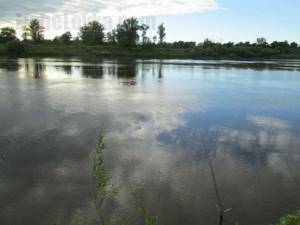
Photo 1. At the exit from the pit.
Gradually, as the temperature drops, the fish begin to move away from many summer camps, gathering in large groups. Now bream is not always caught on familiar edges or dumps; it still needs to be found. Experienced fishermen on familiar bodies of water know where it is best to position the feeder. Beginners will have to experiment with the choice of fishing area and casting distance.
Advice! If the autumn is warm, the bream can adhere to the summer regime almost until mid-October.
In October, the following trend becomes noticeable: in the daytime, large-sized specimens are found less and less often, and bream are more likely to peck. Weighty specimens of bream begin to be taken well in the dark, so experienced fishermen also practice night hunting with a feeder.
Mid and late autumn
With a noticeable cold snap, bream, like many species of peaceful underwater representatives, gathers in large schools and slides down to deep areas, where they subsequently spend the cold period. In mid-October, fish migrations are observed on many rivers, associated precisely with the movement to wintering pits.
While shifting, the bream feeds quite actively, without particularly fumbling with baits. This stage is short-lived, then the bite subsides, and the fish concentrates on the holes, moves little and bites at the exits.
Catching bream in October on a feeder is a successful activity if you choose the right hunting location and select a working bait. Feeders achieve good results at night.
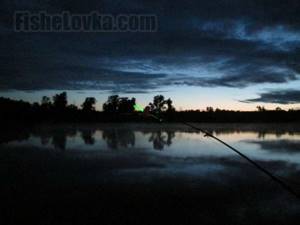
Photo 2. It gets dark early in autumn.
In November, the bream bite gradually subsides. Sometimes you can spend a whole day on a pond without catching a single adult specimen. Late autumn peaceful fish are capricious, do not want to move and it is not always possible to tempt them to bite.
Where to look for fish sites on rivers and lakes
Autumn searches depend on the type of reservoir. On closed ones, the bream sits in deep holes, where there are steep edges and sharp drops. The fish does not like a smooth descent of the bottom. It is better to cast the feeder from a boat in large lakes and reservoirs. This makes it easier to catch fishable areas.
On rivers, bream prefers to be in:
- deep pools, holes with a hard bottom;
- canals along the riverbed with edges;
- places where the current is slow or swirling;
- snags along the cliff.
Flocks roam in search of food near the bridge supports. You can find fish in the middle of the riverbed, where there is a lot of shell rock and pebbles at the bottom. In October, bream rarely appear on beach areas. It greedily grabs food at the average depth of the sandy bottom at night. But it prefers to walk in places where aquatic vegetation is found on the bottom.
Before you start fishing, you need to probe the proposed parking areas. It is impossible to carry out the procedure from the shore. From the boat they make several casts along the river bed, where the bottom is strewn with pebbles. Do not ignore steep banks. They are washed away by water, releasing food for schools of fish.
Food preferences of bream in autumn
The diet of bream in autumn differs from that in summer. He gravitates more and more towards protein foods, and, therefore, gives preference to animal baits. At the beginning of autumn, while the water has not yet cooled, fish are still caught using plant baits, the main ones of which are:
- canned corn;
- steamed pearl barley;
- dough;
- mastyrka.
As cold weather approaches, bream abandons baits of plant origin and completely switches to animal baits. The best, perhaps, is maggot or a sandwich made from it with a worm.
Advice! In October and November, when going for bream, you can completely abandon vegetable baits. The main thing is to take three main animal baits: maggots, bloodworms and worms.
In November, when it becomes very cold, a predisposition of bream to bloodworms has been noticed on many rivers and reservoirs. Usually a bunch of larvae are placed on the hook. But, the closer to winter, the more their number should decrease, since the fish are very capricious and behave warily.
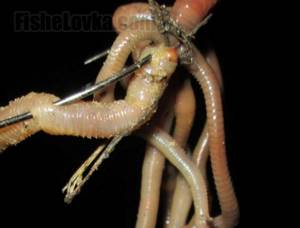
Photo 3. A bunch of worms is autumn bait.
What is the best time to fish?
Most suitable watches:
- In September at early dawn until 9-10 am. From time to time the fish bite at dusk.
- In mid-autumn from morning until, occasionally, noon. Bream often go out to search for food at night.
- In late autumn at midnight and until 2-3 am.
- The biting mode is maintained until ice sets in the reservoirs. To make fishing at night successful, you should install a guard, sound or luminous, on your rod.
- A fishing rod stand is also equipped with similar devices. When fishing from a boat, you need an anchor that can stay in one place.
Catching bream in the fall is interesting. The main thing is to find fishing spots and prepare your gear. You should opt for a feeder as the most catchy gear for this time of year.
